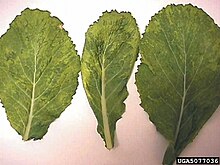Turnip mosaic virus
| Turnip mosaic virus | |
|---|---|
 | |
| Leaves showing interveinal chlorosis, puckering and distortion. | |
| Virus classification | |
| (unranked): | Virus |
| Realm: | Riboviria |
| Kingdom: | Orthornavirae |
| Phylum: | Pisuviricota |
| Class: | Stelpaviricetes |
| Order: | Patatavirales |
| Family: | Potyviridae |
| Genus: | Potyvirus |
| Species: | Turnip mosaic virus |
| Synonyms | |
| |
Turnip mosaic virus (TuMV) is a Potyvirus of the family Potyviridae that causes diseases in cruciferous plants, among others. The virus is usually spread by 40-50 species of aphids in a non-persistent manner. Infected plants, especially the natural hosts, show symptoms such as chlorotic local lesions, mosaic, mottling, puckering or rugosity. TuMV is a positive-sense single stranded RNA virus, consisting of a non-enveloped, helical capsid that is filamentous and flexuous, with an average length of 720 nm. The TuMV genome is linear and monopartite (single particle). The virus has a thermal inactivation point (TIP) of 62 °C, and longevity in vitro (LIV) of 3–4 days.
Evolution
This virus probably evolved from a virus of wild orchids in Germany spreading to wild and domestic brassicas.[1] Via Southern Europe it moved to Asia Minor within the last 700 years.
References
- ^ Yasaka R, Fukagawa H, Ikematsu M, Soda H, Korkmaz S, Golnaraghi A, Katis N, Ho SYW, Gibbs AJ, Ohshima K (2017) The timescale of emergence and spread of Turnip Mosaic Potyvirus. Sci Rep 7(1):4240
External links
- [1]
- [2]
- [3]











